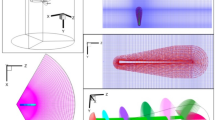Abstract
Within the EU and North Rhine-Westphalia funded research project AVIGLE, the Institute of Flight System Dynamics develops a multi functional flight platform in a tiltwing configuration. The different mission requirements as well as the specific requirements due to the tiltwing configuration influence the design process. Within each specification step, the impact on horizontal and vertical flight, including transition states in between has to be considered. Beside numerical flow analysis, extensive wind tunnel tests were conducted to confirm the calculated coefficients and derivatives and to gain data needed to build a six degrees of freedom simulation for development of controlling strategies in transition. Particular emphasis was put on the influence of the propeller induced slipstream on the aerodynamic coefficients and the stability analysis during transition phases between horizontal and vertical flight.












Similar content being viewed by others
Abbreviations
- CFD:
-
Computational fluid dynamics
- LTE:
-
Long-term evolution
- UAV:
-
Unmanned aerial vehicle
- VTOL:
-
Vertical takeoff and landing
- A H :
-
Tailplane area
- AR:
-
Aspect ratio
- A R :
-
Rotor area
- A V :
-
Fin area
- A W :
-
Wing area
- A x,z :
-
Drag reference area
- C D :
-
Drag coefficient of the wing
- C L :
-
Lift coefficient
- D :
-
Overall drag
- D W :
-
Airfoil drag
- L T :
-
Lift of the tailplane
- L W :
-
Lift of the wing
- M W :
-
Pitching moment of the wing
- P el,0 :
-
Electrical power during hovering
- T :
-
Thrust
- \(V_{\infty}\) :
-
Freestream velocity
- V W :
-
Velocity at the wing
- V Prop :
-
Propeller-induced slipstream
- W :
-
Weight
- X :
-
Forces in x f -direction
- Z :
-
Forces in z f -direction
- b :
-
Wingspan
- c :
-
Chord length
- c o :
-
Outer chord
- c r :
-
Root chord
- l μ :
-
Mean wing chord
- r H :
-
Distance to tailplane
- r V :
-
Distance to fin
- u :
-
Horizontal velocity
- w :
-
Vertical velocity
- x :
-
x-axis specified through index
- y :
-
y-axis specified through index
- z :
-
z-axis specified through index
- x R :
-
Distance to tilt axis in x f -direction
- z R :
-
Distance to tilt axis in z f -direction
- α:
-
Angle of attack
- β:
-
Side slip angle
- \(\zeta\) :
-
Rudder deflection
- η:
-
Elevator deflection
- ηMotor :
-
Motor efficiency factor
- ηProp :
-
Propeller efficiency factor
- κ:
-
Slipstream flap deflection
- ξ:
-
Aileron deflection
- ρ:
-
Density
- σ:
-
Incidence angle of the wing
- f :
-
Coordinate system along aircraft axis
- k :
-
Coordinate system along flight path
References
Rohde, S., Goddemeier, N., Wietfeld, C., Steinicke, F., Hinrichs, K., Ostermann, T., Holsten, J., Moormann, D.: AVIGLE: a system of systems Avionic Digital Service Platform based on micro unmanned aerial vehicles. In: IEEE International Conference Systems, Man, and Cybernetics (SMC), Instanbul, Turkey (2010)
Pegg, R.J.: Summary of Flight-Test Results of the VZ-2 Tilt-Wing Aircraft. Technical Report on NASA TN D-989, NASA (1962)
Ransone, R.: XC-142A V/STOL Transport Tri-Service Limited Category 1 Evaluation. Technical report on air force flight test center EDWARDS AFB, CA (1966)
Fay, C.B.: A cursory analysis of the VTOL tilt-wing performance and control problems. Ann. N. Y. Acad. Sci. 107, 102–146 (1963)
McKinney, M.O., Kirby, R.H., Newsom, W.A.: Aerodynamic factors to be considered in the design of tilt-wing V/STOL airplanes. Ann. N.Y. Acad. Sci. 107, 221–248 (1963)
Hargraves, C.: An analytical study of the longitudinal dynamics of a tilt-wing vtol. Princeton University, New Jersey (1961)
Stapleford, R., Wolkovitch, J., Magdaleno, R., Shortwell, C., Johnson, W.: An analytical study of v/stol handling qualities in hover and transition. Technical report on systems technologyinc., Hawthorne, CA (1965)
Williams, J.L.: Extraction of longitudinal aerodynamic coefficients from forward-flight conditions of a tilt wing v/stol airplane. Technical Report on NASA TN D-7114, NASA (1972)
Straeter, B.: Ein Beitrag zum Problem der Propeller-Fluegel-Interferenz = A contribution to propeller wing interference problems. Dissertation, Technische Hochschule Darmstadt (1976)
Ostermann, T., Holsten, J., Moormann, D.: Entwicklung eines autonom operierenden Tiltwing-UAV fuer den Einsatz in selbstorganisierenden Drohnenschwaermen = Development of an Autonomous Tiltwing UAV for the Operation in Self-organized Drone Swarms. In: Deutscher Luft- und Raumfahrtkongress 2010 : Hamburg, 31.8.–02.09.2010; Tagungsband - Ausgewaehlte Manuskripte, DGLR, Bonn (2010)
Andre Deperrois, XFLR5—Analysis of foils and wings operating at low Reynolds numbers http://xflr5.sourceforge.net/xflr5.htm
Mueller, F., Thomas, D.: Flugzeugentwurf Entwurfssystematik, Aerodynamik, Flugmechanik und Auslegungsparameter fuer kleinere Flugzeuge =Airplane design for small aircraft. Luftfahrtverlag TFT (2003)
USAF MIL-1797-A, Military Standard, Flying Qualities of Piloted Vehicles (1990)
Etkin, B.: Dynamics of Flight, Stability and Control. Wiley, New Jersey (1995)
Williams, J.E., Vukelich, S.R.: The USAF Stability and Control Digital DATCOM, Volume I, Users Manual. McDonnell Douglas Astronautics Company, St Louis, Missouri 63166, affdl-tr-76-45 edn.http://www.holycows.net/datcom/USAF_DATCOM_UM (1976)
Johnson, W.: Helicopter Theory, Princeton University Press, Princeton (1980)
Acknowledgments
Our work has been conducted within the AVIGLE project, which is part of the Hightech.NRW research program funded by the German Ministry for Innovation, Science and Research in North Rhine-Westphalia and the EU. AVIGLE is conducted in cooperation with several industrial and academic partners. We thank all project partners for their work and contributions to the AVIGLE project.
Author information
Authors and Affiliations
Corresponding author
Additional information
This paper is based on a presentation at the German Aerospace Congress, September 27--29, 2011, Bremen, Germany.
Rights and permissions
About this article
Cite this article
Holsten, J., Ostermann, T. & Moormann, D. Design and wind tunnel tests of a tiltwing UAV. CEAS Aeronaut J 2, 69–79 (2011). https://doi.org/10.1007/s13272-011-0026-4
Received:
Revised:
Accepted:
Published:
Issue Date:
DOI: https://doi.org/10.1007/s13272-011-0026-4




